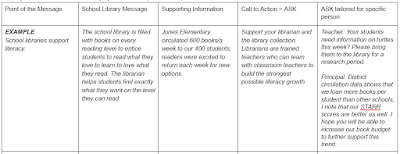By Dorcas
Hand, Editor of TASLTalks
As a member
of a non-library board, I am learning a little about fundraising techniques. After
participating in this organization’s board discussions, I’ve been struck by the
fact that those techniques are remarkably similar to what we call “advocacy” in
schools and libraries.
The biggest point of commonality? In order to get results, we have to be
really clear about our message. What is the bottom line for our “ask?”
You’ve been
reading in the library literature about
elevator speeches and such forever. But then this new approach – this
key message grid – landed in my inbox from the other organization. It looks like this:
The minute I
saw this, my board member hat fell off as the wheels began spinning: how could I make this work for school libraries. It is such a simple, step-by-step method to build your talking
points. You can see this example is very basic, working to get more face time
with students – but it works for more sophisticated topics as well.
This second
one doesn’t yet have the last column, but I think you get the general idea.
Make it work for you! Whether it is an elevator speech you need, or a project/program
proposal, this method is helpful – with every audience, depending how you focus
the supporting info and the Ask.
ALA offers ESSA Elevator Speech Examples planned by the same grid approach. I guess my discovery isn't so new - but maybe you didn't know it either and will find it useful. And we're all working on ESSA topics these days!
Go ahead,
pick any general point you want to make. Take it from a general statement to directed content specific to your library and your community. Build in your supporting info.
What do you want to happen after your audience hears this info? How can you
tailor it even more to the specific person or group so that they can see
exactly what they might do to support your school library. “Mr. Smith, please
stop by to see the work second graders have done learning about turtles using
library resources. I’d love to chat about ways to make the library even
better.” “Mr. Smith, third grade has enjoyed using iPads to find the right
books for their library research – they just don’t have internet or books at
home. We would love more iPads – I think PTA might help us, with your support.”
I offered a template to the Key Message Grid at the District 10 Fall conference - perhaps it will make your job easier.
In some
ways, this is just the same thing we’ve always done – but the grid makes it
seem so much clearer and easier. At least to me. So try it. See if you can get
some unexpected results because you have clarified your message and focused it
to a specific person or group. I’d love to hear what results you get!
Use the “Reply” function on this blog – other readers will also appreciate your
applications of the grid idea. Really -yes, you!



